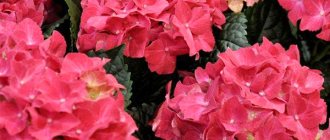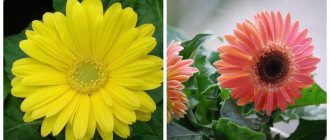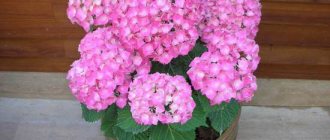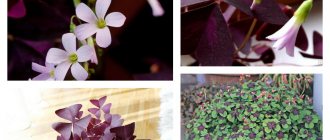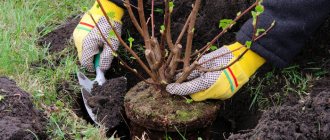Are there indoor hydrangeas?
Growing most garden crops as a houseplant is problematic. To do this, they need to be small, or the owners know how to restrain their growth. They also slowly grew green mass (except for vines), and did not have a very deep and voluminous root system.
Hydrangea only partially meets these requirements. But some varieties of Hydrangea Largeleaf can actually be planted in containers and grown as an indoor flower.
Other indoor species are more affected. Even if they are properly cared for, they usually die during the dormant period and rarely survive until spring.
The plant, which for unknown reasons is called Hydrangea Jasmine, is actually Gardenia. It is united with hydrangea by belonging to the Dicotyledonous class. In botany, such cultures are not even considered related.
Hydrangea varieties for Siberia in open ground
The variety of hydrangea paniculata “Silver Dollar” has been prepared for the weather of Siberia - a two-meter bush with white flowers arranged in the shape of a cone. By winter, the color changes to pinkish. In addition to him, “Pinky Winky” and “Phantom” have already earned fame. Low varieties have also taken root - “Bobo”, as well as “Sandalwood” and “Vanilla Fresh”.
Tree hydrangea is adapted to Siberian winters just like its “sister”. Among her varieties are “Strong Annabelle” and simply “Annabelle”, “Grandiflora” and “Invincible”.
Indoor varieties
Large-leaved hydrangea (Hydrangea macrophylla) is the only species suitable for indoor growing. This is a shrub with straight, weakly branched shoots that do not become woody for a long time. In potted culture it reaches a maximum of 1 m.
The leaves are large, oval, with a sharp crown and jagged edge, bright green. The flowers are collected in corymbs at the tips of last year's shoots. They are usually colored in all shades of pink, but there are red and white varieties.
Two types of whisks:
- small fertile, absent in some cultivars;
- barren large.
When growing hydrangea as a houseplant, you need to choose the right variety.
It must meet the requirements:
- good immunity - the flower will already be in cramped and uncomfortable conditions, a capricious cultivar simply will not survive;
- compact bush;
- height less than 1 meter;
- ability to grow continuously in a small volume of soil;
- beautiful flowers.
The following varieties can be grown as domestic hydrangea:
- Mini Penny grows up to 60-90 cm, the shield is a pink hemisphere 15-20 cm;
- Mireille - rhombic petals, which is clearly visible in the photo, white with a crimson edging and a dot in the center, the bush is the same height as the previous variety;
- Tovelite in a container reaches half a meter or a little more, the corollas look like pink stars, the shields are flattened, with a cross-section of 12 cm;
- Miss Saori produces white double flowers with variable edge colors - from terracotta to pink or crimson;
- The cauldron reaches 40-60 cm, the shields are spherical, up to 25 cm, the corollas are terry, milky with a very pale pink tint, when blooming the buds in the center are lime-colored;
Maculata - in Russia it can only be grown as an indoor crop; it is distinguished by variegated leaves and flat viburnum-shaped inflorescences; lilac fruiting corollas are framed by large, sterile, white ones.
Maculata
Maculata
Tovelit
Mini Penny
Types of hydrangeas most popular among gardeners
Garden hydrangeas have become widespread. They can reach impressive sizes, but most modern varieties are 1.5 - 3 meters tall.
Hydrangea largeleaf
Large-leaved hydrangea is characterized by inflorescences in the form of corymbs; they come in different colors.
On alkaline soil, its flowers acquire a pink or lilac tint, and on acidic soil, blue. This occurs due to the plant’s ability to absorb aluminum released from highly acidic soil.
Tree-like
Tree hydrangea has large inflorescences, shaped like a ball, white or light beige in color. It is quite frost-resistant, and after freezing it grows new shoots well.
Paniculata
Hydrangea paniculata grows as a tree or shrub. The inflorescences look like a panicle. After the buds bloom, they are white in color, then turn pink.
Flowering period
In the garden, the culture blooms buds from July to August. Usually the plant is at its peak for about 1.5 months. But modern remontant varieties have appeared, producing scutes first at the ends of last year’s shoots, then on young growth.
When cared for at home, indoor hydrangea blooms depending on when it had a dormant period. Every year, the crop must rest for at least 70-80 days at a temperature of 0 to +10 ° C, otherwise it will become weak, begin to get sick, and will not bloom.
It is easier to arrange a dormant period for indoor hydrangea in winter. It is transferred to the basement, a frost-free utility room, and placed on a glazed balcony.
When they want to achieve flowering, indoor hydrangea is “awakened”:
- take it out into the sun;
- water with warm water;
- fed.
Soon the bush begins to bloom, and often produces scutes simultaneously with young leaves. When there are several pots, you can “wake up” the plants one at a time.
If old buds are cut off as soon as they lose their decorative properties, and indoor hydrangeas are taken care of well, even non-remontant varieties can sometimes bloom again.
Pink corollas have an unstable color. This means that when special fertilizers or preparations are used, they turn blue or cyan.
Only hydrangeas that produce rounded caps can change color. The varieties of the Japanese group have flat shields; it is useless to water them with special preparations; they will not turn blue anyway.
You can often come across the statement that if wintering is warm, indoor hydrangea will bloom next time in the cold season. Maybe. When the owners are able to arrange a period of rest with a decrease in temperature to 5-10 ° C in the summer or early autumn. If the plant is simply not allowed to rest, it will most likely wither and die.
What to do with a flower after purchase
Caring for hydrangea at home begins with quarantine. The plant should be kept separate from the main collection for 2 weeks so as not to become a carrier of diseases or pests.
Next, most sources recommend replanting your indoor hydrangea. This is a good idea. Moreover, peat in pots is often not ordinary sour, but exhausted, left over after growing cut flowers, impregnated with unknown preparations and with an unknown acidity.
Definitely needs to be transplanted:
- non-blooming hydrangea purchased at a sale;
- transfer the hydrangea with buds and a good, healthy root into a large pot (minimum 5 liters) without disturbing the coma.
If the substrate is sour or spoiled, the underground part is rotting, soil pests are detected, a complete transplant of the indoor hydrangea is performed. Flowers will have to be sacrificed.
Beneficial features
Possessing positive, bright energy, the flower spreads calm tranquility. From the point of view of Feng Shui, it has many useful properties:
- extinguishes mutual hostility, softens conflict in communication;
- in a home environment normalizes family relationships, helps to achieve mutual understanding;
- contemplation of hydrangea relieves mental fatigue after an incident or stress, helping to calm down;
- a flowering plant relieves bad mood, negativity of others, bad thoughts.
On a note. In order for the beneficial properties to be fully revealed, optimal conditions for growth are selected for the flower.
Home care
The plant is uncomfortable indoors, so its maintenance cannot be called simple. But if all the requirements of the culture are met and the substrate is selected successfully, the bush will be able to grow and bloom indoors for years.
Lighting and temperature
Hydrangea is a short-day plant. Large-leaved plants suffer from excess sun more than other species, and they are grown indoors.
The flower needs 6-10 hours of light per day. It is better to place hydrangea on a western windowsill. In the south or east, the bush will have to be shaded.
Culture doesn't like heat. In summer it requires cool keeping; it is undesirable for the temperature to rise above 20° C. Spraying and airing will not help make the life of hydrangea more comfortable.
During the rest period, a temperature of 8-10° C is recommended. It can drop to 0° C, and according to some reports, be -5° C, but it is better not to risk it.
Without a cool rest for 2.5-3 months, indoor hydrangea may not bloom.
Watering and air humidity
Hydrangea is a well-known water plant, which is reflected in the name of the plant. During the growing season, the soil should be constantly moist. During rest periods, irrigation is reduced.
Hydrangea does not tolerate watering with hard water. It needs:
- filter;
- to defend;
- freeze;
- boil.
At least once a month, the flower must be watered with acidified water.
Air humidity should be high at all times. Simply spraying hydrangea daily is not enough; bowls of water are placed next to the flower, the pot is placed on wet pebbles, in a pot with wet sphagnum.
Feeding
Hydrangea is fertilized every 10-14 days constantly, except for the dormant period. It is better to buy specialized preparations for hydrangea or indoor conifers.
If the owners are going to change the color of the flower, you can not buy specialized fertilizer, but additionally feed:
- iron sulfate;
- alum;
- aluminum sulfate;
- boric acid.
Trimming and shaping
The operation is performed immediately after the scutes wither. If flowering, which is the norm for indoor conditions, occurs in spring or early summer, short pruning stimulates the formation of new branches. By the end of the season they will get stronger, and after a period of rest they will release buds.
But, if the peak of decorativeness occurs in mid-summer or autumn, it’s not worth the risk. Only the shield itself is removed, without touching the bracts, which are often not visible under the hydrangea’s cap. It is from their axils that new inflorescences are likely to appear next season.
In spring, it is recommended to thin out overgrown indoor hydrangeas. At ground level, cut off any weak or thin stems.
If there are too many strong shoots, some are removed - this way the hydrangea will not waste energy and plastic substances on their maintenance, the caps increase in size and last longer.
Pests and diseases of hydrangea
If the humidity is too high, hydrangea is affected by gray rot, which can be dealt with by treating the plant with Bordeaux mixture, and downy mildew, which is destroyed by copper-containing preparations or fungicides. If there is insufficient moisture, hydrangeas are harmed by spider mites and aphids, which are destroyed by double treating the plant with a soap solution or actellik at weekly intervals.
Hydrangea turns yellow
Most often, the cause of discoloration of hydrangea leaves is a violation of the rules of care - insufficient watering of the plant, lack of nitrogen in the soil, or a disease such as chlorosis, which occurs due to the fact that the soil in the pot is too alkaline. Correct your mistakes and the plant will get better.
Hydrangea is drying
Sometimes this happens simply because you forget to water and spray it, sometimes because of a lack of nutrients in the soil or because the roots of the plant were injured during an awkward transplant, that is, in any case, due to a violation you rules for caring for a flower. Change your attitude to the rules: if you strictly follow them, which in itself is not difficult, you will not have problems with either hydrangea or any other plant.
Hydrangea falls
As a rule, falling is the next stage after the leaves dry out. The plant needs not just abundant watering, but regular moistening of both the soil and the air, so water the soil and spray the hydrangea leaves as the need arises.
Hydrangea doesn't bloom
This can happen if the hydrangea did not rest in winter - it used up its energy on flowering, and it was not possible for it to accumulate new ones on the windowsill near the hot radiator, and this is not its fault. She needs complete rest for 70-80 days in a cold, dark room, even if she does not look like an exhausted plant - the leaves have not fallen or dried out. Find a room or basement suitable for the dormant period, remove all the leaves, shorten the strong shoots by half, cut off the weak shoots at the root, take the pot with the plant to a suitable room and lay it on its side. This needs to be done in December, so that in February you can bring the hydrangea back to life. By observing this ritual annually, you can be sure that the hydrangea will definitely bloom in due time.
How to replant at home
This is the most important element of caring for potted hydrangea. The operation is carried out every 2-3 years and differs from transplanting ordinary indoor flowers. It is better if it is done using the transshipment method, without destroying the earthen clod:
- Drainage is placed in the new pot and a little fresh substrate is added.
- Place a hydrangea in the center.
- The free space is filled with soil.
- Compact and water.
If the root rots or the substrate has deteriorated, there is a high probability that after completely replacing the soil and stripping the lower shoots, the hydrangea will not take root in the flowerpot, but will begin to wither and die. It is better to plant in open ground.
Choosing a pot
The container needs a regular shape, with bottom holes. If a smaller volume is not indicated in the variety description, for a developed bush it should be at least 5 liters. For a young plant or cuttings, 2-3 liters will be enough.
With each transplant, the size of the pot of indoor hydrangea is increased by 1.5 times, and not by 2-3 cm, as for other crops. When the container is needed too large, the bush is divided into parts or transferred to the garden.
What kind of soil does potted culture like?
This is where the problems begin. Hydrangea needs a soil acidity of 5-5.5, and in store-bought mixtures, even if the required numbers are indicated on the package, the pH is usually kept at 6-6.5.
It is better to prepare the substrate yourself:
- sour peat – 2 parts;
- pine litter or litter – 2;
- completely rotted humus – 1;
- sand – 0.5.
In the future, you will have to buy a device to measure soil acidity. Without this, indoor hydrangea will not live long - the pH level changes over time due to watering and fertilizers. It may need to be stabilized with acidified water or special preparations.
Hydrangea wintering in open ground
Varieties bred specifically for cold climates are ready for winter from the very beginning. The first time after placing them in the ground, their root neck still needs to be covered with dry soil until the cold weather. The very place where the roots lie should be insulated with spruce branches.
Of all the varieties, the type of large-leaved hydrangea withstands winter the worst. For safety, it is as if they are burying it, pressing the branches tightly and covering it entirely with earth. Usually the bending process begins in the second half of autumn, as it requires effort and time. The older the plant, the longer it resists, but when the branches are bent, they need to be laid on a bed of spruce branches or boards with plywood. The bush laid in this way is covered with spunbond and pressed with stones. An aged bush cannot be bent down without breaking the branches. It is usually tied.
For tying, non-woven material is used, which securely swaddles the branches. After which a cylindrical frame of metal rods is erected around the bush. Its walls should be more than 20 cm away from the branches, and in height - rise above the upper branches by at least ten centimeters. All free space is filled with dry leaves. This will insulate the bush and help withstand the cold.
In the southern regions with snowy, short winters, hydrangea overwinters without such tricks. The ability to survive in the cold also depends on how old the plant is. “Old people” suffer from frost less than “young people”.
Reproduction methods
Indoor hydrangea is easy to propagate vegetatively:
- Cuttings - the 7-10 cm long shoot tips remaining after pruning can be rooted in water or perlite. Often they produce buds without even having time to produce lower shoots. The first inflorescences must be removed immediately.
- Divide the bush when an indoor hydrangea requires a pot that is too large.
- It is inconvenient to plant layering in a container, but some amateurs succeed. Only the branch needs to be secured well.
It is almost impossible to obtain your own hydrangea seeds indoors. They are bought, scattered at the end of winter on the surface of a light substrate, and covered with glass. Keep at high humidity and temperature 22-25° C in the light.
Problems when growing at home
The plant rarely gets sick, but can be colonized:
- whitefly;
- mealybug;
- spider mite;
- aphids;
- thrips.
The flower suffers if care for indoor hydrangea is incorrect:
- the plates turn yellow due to chlorosis or low acidity of the substrate;
- leaves turn black - watering with cold water, root rotting due to acidification of the soil;
- tips dry - dry air or soil;
- brown spots appear - most likely, insufficient watering;
- light marks on the plates – excess sun;
- slow growth – nutritional deficiency.


